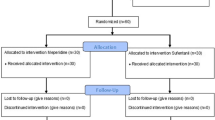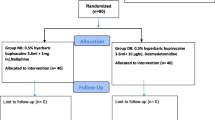Abstract
Introduction
Opioids are commonly added to local anaesthetic for subarachnoid block for caesarean section due to their synergistic effects. The physiochemical characteristics of opioids suggest premixing with hyperbaric bupivacaine may limit their distribution within the CSF. We studied the effect of a separate injection with a combination of bupivacaine, morphine and fentanyl on block characteristics, haemodynamic changes, postoperative pain and patient satisfaction.
Method
Following ethical approval and informed consent, a prospective double-blinded randomised controlled trial was performed in a university hospital. A total of 126 patients undergoing caesarean section were randomised to two groups. In group M, the premixed group, patients received 12 mg of hyperbaric bupivacaine, 20 mcg of fentanyl and 100 mcg of morphine injected as a single mixture. In group S, the separate injection group, patients received the same drugs in separate injections. Measurements included haemodynamics, block distribution, intra- and postoperative pain, as well as patient satisfaction.
Results
Patients in both groups had similar block height, time to maximum sensory block, time to block regression and motor block. However, haemodynamics were different between the groups. The proportion of systolic hypotension episodes was greater in group S [159/1320 (12.05%)] than group M [113/1452 (7.78%)], with P = 0.0002. Moreover, a greater amount of ephedrine was administered in group S than group M, with values 12.09 (8.1) and 9.09 (8.5) mg respectively (P = 0.001). Additionally, postoperative pain, as measured by the Visual Analogue Scale (VAS), was greater in group M, with a VAS of 4.6 (1.7), vs. group S, which recorded a VAS of 3.8 (2.0) (P = 0.017).
Conclusion
Sequential injection of intrathecal opioids and hyperbaric bupivacaine resulted in greater early haemodynamic instability and slightly better postoperative analgesia without any difference in block height or patient satisfaction.
Clinical trial registration
NCT04403724.


Similar content being viewed by others
References
Betran AP, Ye J, Moller A-B et al (2021) Trends and projections of caesarean section rates: global and regional estimates. BMJ Glob Health 6:e005671
Uppal V, Retter S, Casey M et al (2020) Efficacy of intrathecal fentanyl for cesarean delivery: a systematic review and meta-analysis of randomized controlled trials with trial sequential analysis. Anesth Analg 130:111–125
Roofthooft E, Joshi GP, Rawal N, Van de Velde M (2021) PROSPECT Working Group of the European Society of Regional Anaesthesia and Pain Therapy and supported by the Obstetric Anaesthetists’ Association. PROSPECT guideline for elective caesarean section: updated systematic review and procedure-specific postoperative pain management recommendations. Anaesthesia 76(5):665–680
Günaydin B, Güngör İ, İzdeş S (2012) Final baricity of ropivacaine or bupivacaine combined with fentanyl for intrathecal administration. Turkish Journal of Medical Sciences 42:942–945
Imbelloni LE, Moreira AD, Gaspar FC et al (2009) Assessment of the densities of local anesthetics and their combination with adjuvants: an experimental study. Rev Bras Anestesiol 59:154–165
Heller AR, Zimmermann K, Seele K et al (2006) Modifying the baricity of local anesthetics for spinal anesthesia by temperature adjustment: model calculations. The Journal of the American Society of Anesthesiologists 105:346–353
Richardson MG, Wissler RN (1996) Density of lumbar cerebrospinal fluid in pregnant and nonpregnant humans. The Journal of the American Society of Anesthesiologists 85:326–330
Practice guidelines for obstetric anesthesia (2016) an updated report by the American Society of Anesthesiologists Task Force on Obstetric Anesthesia and the Society for Obstetric Anesthesia and Perinatology. Anesthesiology 124(2):270–300
Seki H, Shiga T, Mihara T et al (2021) Effects of intrathecal opioids on cesarean section: a systematic review and Bayesian network meta-analysis of randomized controlled trials. J Anesth 35(6):911–927
Gray JR, Fromme GA, Nauss LA et al (1986) Intrathecal morphine for post-thoracotomy pain. Anesth Analg 65:873–876
Desai N, Gardner A, Carvalho B (2019) Labor epidural analgesia to cesarean section anesthetic conversion failure: a national survey. Anesthesiol Res Pract 2019:6381792
Chekole AT, Kassa AA, Yadeta SA, Aytolign HA (2022) Comparison of sequential versus pre mixed administration of intrathecal fentanyl with hyperbaric bupivacaine for patients undergoing elective caesarean section at Zewditu memorial referral hospital: a prospective cohort study. Ann Med Surg (Lond) 74:103313
Keera AAI, Elnabtity AMA (2016) Two syringe spinal anesthesia technique for cesarean section: a controlled randomized study of a simple way to achieve more satisfactory block and less hypotension. Anesth Essays Res 10:312
Ginosar Y, Mirikatani E, Drover DR et al (2004) ED50and ED95of intrathecal hyperbaric bupivacaine coadministered with opioids for cesarean delivery. The Journal of the American Society of Anesthesiologists 100:676–682
Ousley R, Egan C, Dowling K, Cyna A (2012) Assessment of block height for satisfactory spinal anaesthesia for caesarean section. Anaesthesia 67:1356–1363
Morgan P, Lo J, Halpern S (1999) The development of a maternal satisfaction scale for caesarean section. Int J Obstet Anesth 8:165–170
Desai S, Lim Y, Tan C, Sia A (2010) A randomised controlled trial of hyperbaric bupivacaine with opioids, injected as either a mixture or sequentially, for spinal anaesthesia for caesarean section. Anaesth Intensive Care 38:280–284
Kocarev M, Watkins E, McLure H et al (2010) Sensory testing of spinal anaesthesia for caesarean section: differential block and variability. Int J Obstet Anesth 19(3):261–265
Sachan P, Kumar N, Sharma J (2014) Intrathecal clonidine with hyperbaric bupivacaine administered as a mixture and sequentially in caesarean section: a randomised controlled study. Indian J Anaesth 58:287
Hare GM, Ngan J (1998) Density determination of local anaesthetic opioid mixtures for spinal anaesthesia. Can J Anaesth 45:341–346
Wang C, Chakrabarti MK, Whitwam JG (1993) Specific enhancement by fentanyl of the effects of intrathecal bupivacaine on nociceptive afferent but not on sympathetic efferent pathways in dogs. The Journal of the American Society of Anesthesiologists 79:766–773
Riley ET, Walker D, Hamilton CL, Cohen SE (1997) Intrathecal sufentanil for labor analgesia does not cause a sympathectomy. The Journal of the American Society of Anesthesiologists 87:874–878
Gaiser RR, Cheek TG, Gutsche BB (1998) Comparison of three different doses of intrathecal fentanyl and sufentanil for labor analgesia. J Clin Anesth 10:488–493
Grant GJ, Susser L, Cascio M et al (1996) Hemodynamic effects of intrathecal fentanyl in nonlaboring term parturients. J Clin Anesth 8:99–103
Kanwariya A, Khatri C, Janweja S (2020) Intrathecal administration of fentanyl with hyperbaric bupivacaine either a mixture or sequentially in elective caesarean section: a randomised single blind study. J Clin of Diagn Res 14(6):UC06-UC10
Akerman N, Saxena S, Wilson R, Columb M, Lyons G (2005) Effect of intrathecal diamorphine on block height during spinal anaesthesia for caesarean section with bupivacaine. BJA: British Journal of Anaesthesia 94:843–847
Joshi S, Tailor R, Pandya M, Vachhrajani P (2018) Two syringe technique for spinal anesthesia in cesarean section: a study of a simple way to achieve more satisfactory block, less frequency of hypotension and prolong analgesia. International Journal of Science and Research 7:1984–1988
Shivashankar A, Rath P, Iyer SS, Mohan C (2017) Combination of buprenorphine with hyperbaric bupivacaine administered either as a mixture or sequentially for spinal anaesthesia for caesarean section. Indian Journal of Clinical Anaesthesia 4:291–297
Barada M, Kanawati S, Rajab O, Naja Z (2021) Subdural injection: a possible cause of loss of consciousness during cesarean section. Journal of Obstetric Anaesthesia and Critical Care 11:46–47
Jasinski T, Migon D, Sporysz K et al (2021) The density of different local anesthetic solutions, opioid adjuvants and their clinically used combinations: an experimental study. Pharmaceuticals (Basel) 14(8):801
Singh NP, Makkar JK, Jafra A et al (2022) The effect of two groups of intrathecal fentanyl doses on analgesic outcomes and adverse effects in parturients undergoing cesarean delivery: a systematic review and meta-analysis of randomized controlled trials with trial sequential analysis. Int J Obstet Anesth 50:103270
Jahanara HSK, Asthana V, Nautiyal R (2020) Comparison of premixed with sequential administration of intrathecal morphine and hyperbaric bupivacaine for lower segment caesarean section. Academia Anesthesiologia International 5:174–178
Funding
Departmental funding only.
Author information
Authors and Affiliations
Corresponding author
Ethics declarations
Conflict of interest
The authors declare no competing interests.
IRB
IRB number 17300377.
Additional information
Publisher's Note
Springer Nature remains neutral with regard to jurisdictional claims in published maps and institutional affiliations.
Rights and permissions
Springer Nature or its licensor (e.g. a society or other partner) holds exclusive rights to this article under a publishing agreement with the author(s) or other rightsholder(s); author self-archiving of the accepted manuscript version of this article is solely governed by the terms of such publishing agreement and applicable law.
About this article
Cite this article
Moustafa, M.M.I., Ali, M.S., McCaul, C. et al. Comparison of sequential and mixture injections of opioids and hyperbaric bupivacaine for subarachnoid block for lower segment caesarean section: a randomised controlled study. Ir J Med Sci (2024). https://doi.org/10.1007/s11845-024-03682-w
Received:
Accepted:
Published:
DOI: https://doi.org/10.1007/s11845-024-03682-w




